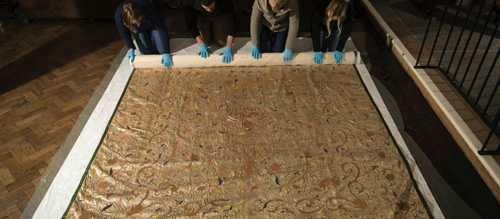
A rare surviving 300 year old bedspread given by James II to some of his loyal supporters, is being conserved by the National Trust and has been put back on display for the first time in a generation at Sizergh Castle in Cumbria. The magnificent satin bedspread, believed to be from Goa, features mythical creatures picked out in gold thread.
Textile specialists are starting conservation work on a 17th-century Goan bedspread, a thank you gift from King James II to a loyal family, at the National Trust’s Sizergh Castle in Cumbria. The magnificent bedspread has recently gone on display at the castle for the first time in more than 30 years.
The Indian bedspread is made from satin, with gold thread stitched into an intricate design of mythical creatures, and was gifted to the Strickland family of Sizergh in the 1600s in thanks for their loyalty for accompanying James II into exile.
Sir Thomas and Winifred Strickland, prominent Catholic royalists, were considered close friends of the King and Queen. They accompanied them into exile in France in 1688, with Lady Strickland serving as acting Governess of the Prince of Wales. Other gifts they received from James II included a lock of the King’s hair and the Queen’s collection of Imari porcelain.
It took seven National Trust staff three hours to painstakingly unroll the 3m x 2.5m counterpane and prepare it for display as part of the castle’s new ‘The Sizergh Silk Road: From Goa to Antwerp’ exhibition, which runs until 27 October.
Jane Clarke, House Steward, said: “The bedspread had been in storage for more than 30 years, so we didn’t know what to expect. We had to work incredibly slowly to support it and prevent any stretch or tension, which could cause irreparable damage to the fabric. Finally seeing it unrolled, its intricate details and colours still vibrant, was fabulous.”
The centrepiece of the bedspread is a double-headed eagle surrounded by flowers, butterflies and birds, while the corners feature unidentified creatures, possibly stylised leopards or lions.
Jane continued: “There were some very beautiful textiles coming out of Goa, then a Portuguese colony, in the 17th-century, and this is a particularly wonderful example with spectacular imagery. Our best guess is that the eagle on it is a Hindu mythical beast, but if visitors know more, we would love to hear their ideas.”
The bedspread includes a number of different stitches and techniques including basket weave, ‘laid couching’ to outline motifs, and satin stitch worked in unspun silk.
The exhibition allows visitors to learn more about how the delicate fabric at Sizergh is cared for and visitors will be able to see a specialist textile conservator working on the bedspread at selected times over the coming months.
The castle is also shining a light on another precious item in its textile collection – a set of five 17th century Flemish tapestries showing Antony and Cleopatra. The wall hangings depict Plutarch’s (and subsequently Shakespeare’s) famous stories and are the largest surviving weaving of this series in the world.
Later this year, the first tapestry in the set, ‘The Meeting of Antony and Cleopatra’, will travel to Belgium for urgent specialist treatment to restore its colour and condition. The treatment for this one tapestry will cost £77,000 so the castle will be raising funds through raffle tickets and donations throughout the year.
The house is open Tuesday-Sunday, 12-4pm, from 16 March-27 October and is free to enter for National Trust members. The gardens, shop and café are open 7 days a week.
